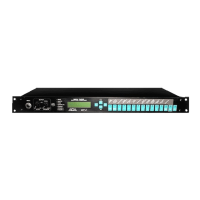Appendix B
MIDI and the MP-2
A brief discussion of the MIDI specification and the portions of it used by the MP-2.
MIDI (Musical Instrument Digital Interface) is the means by which computer-based electronic
musical instruments, such as synthesizers and samplers, and other related equipment can
exchange information. MIDI is a specification agreed upon by the manufacturers of this
equipment, and consists mostly of the definition of a number of software messages that,
taken collectively, comprise something that is part communications protocol, part computer
language, part file format. Technically, it is a one-way serial interface operating at a speed of
31.25 kilobaud. (Two-way MIDI communication is possible, it just entails using two cables
between the devices.) MIDI messages convey information about a musical performance,
though they do not actually carry sound. Think of the modern equivalent of a player piano:
the holes are MIDI note messages (which specify which note was played and how hard),
while the player piano actually producing the sound is a synthesizer or sampler.A sequencer
is a recorder of MIDI data, like a tape recorder, except that it doesn't use tape and it records
MIDI data, not sound. In other words, the sequencer is what takes an actual performance
and makes a MIDI "piano roll." In order to allow multiple devices to be simultaneously but
independently addressed, MIDI uses a channel system similar in concept to television.
When a device is set to one of the 16 MIDI channels, it will respond only to messages
carrying that channel number. Note messages are the most commonly used, but the MP-2
has no need of these. The next most common messages are program change messages.
These tell the receiving device to recall a specific program, or collection of settings, from its
memory. When the MP-2 receives a program change message, it recalls one of the User
programs; it is also capable of transmitting a program change message when a program is
selected from the front panel. MIDI is capable of specifying up to 128 different program
change numbers. The MP-2's MIDI Mapping feature lets you assign each MIDI program
change number to call up anv User program you desire. The MP-2's Panel Mode is a special
feature that allows the MP-2's front panel to act as if it were a MIDI controller plugged into
MIDI In. In this case, you press the MIDI program number on the front panel, and the MP-2
recalls the current User program currently mapped to that MIDI number.lt will also show that
mapping. Many MIDI systems consist of a number of components. In order to achieve the
maximum flexibility with the least effort, it was necessary to devise a system wherein a single
program change message from a source could call up desired programs in all the
components simultaneously, without having to constantly shuffle programs around in
memory to match a program change number.This is the purpose of the MP-2's program
change mapping capability.
Another common type of MIDI message is Continuous Control messages. These are
generally used to gestural controllers like Modulation Wheel and Volume.Interestingly,
switch-type controllers, like Sustain Pedal, are also in this category, even though they are
not actually continuous. The MIDI specification originally defined 124 different controllers,
but later enhancements to the spec allow many more to be defined. A few very important
controllers, notably pitchbend and aftertouch. have their own messages defined and are
not considered part of the Continuous Controller class. The MP-2 can use Continuous
Controller messages to control virtually any of the parameters available in Program Edit
mode, but it does not recognize pitch-bend or aftertouch. The last type of MIDI message
used by the MP-2 is System Exclusive. This type of message was originally intended as a
"trap door" to allow both expansion of the MIDI spec and use by manufacturers of features
unique to their devices. The definition of the basic System Exclusive is quite sparse and
open-ended to give manufacturers the greatest latitude. Each manufacturer uses their own
format for these messages, and only their devices or computer software specifically
Page: 55

